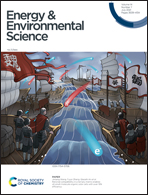Abstract
Shifting towards a circular carbon economy in the face of rising global population and diminishing natural reserves represents one of the greatest challenges facing mankind. CO2 reduction reactions powered by renewable electricity offer a possible route to transform our incumbent linear consumption economic model by tapping into the over 10 gigatonnes of carbon emitted globally each year in the form of CO2. However, many critical questions for CO2 reduction remain unanswered across the varied pathway-product combinations such as (1) what is the near-term economic viability? (2) what opportunities exist for transformational R&D to reduce cost? (3) what is the impact of CO2 price? (4) how does renewable electricity intermittency affect the production costs? Herein we perform a comprehensive economic assessment of CO2 reduction across five major electricity-driven technologies using a scale basis of a 200 million gallon per year bioethanol facility (ca. 600 kilotonnes CO2 per year) as the CO2 source. From this framework we address these key issues and report the outlook for the near-, mid-, and long-term production of 11 promising carbonaceous products while providing guidance to the research community on key cost drivers and R&D needs. Our analysis shows that with modest technical advancements and an accompanying reduction in electricity price to $0.03 kW h−1 and CO2 price to $20 per tonne, 8 out of 11 CO2-derived products have the potential to reach production costs at parity with, or even lower than, current market prices.



 Please wait while we load your content...
Please wait while we load your content...
